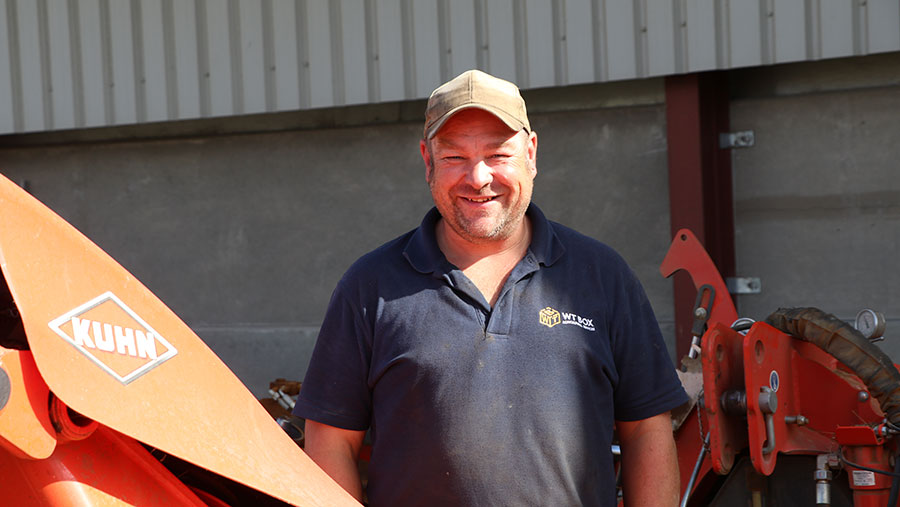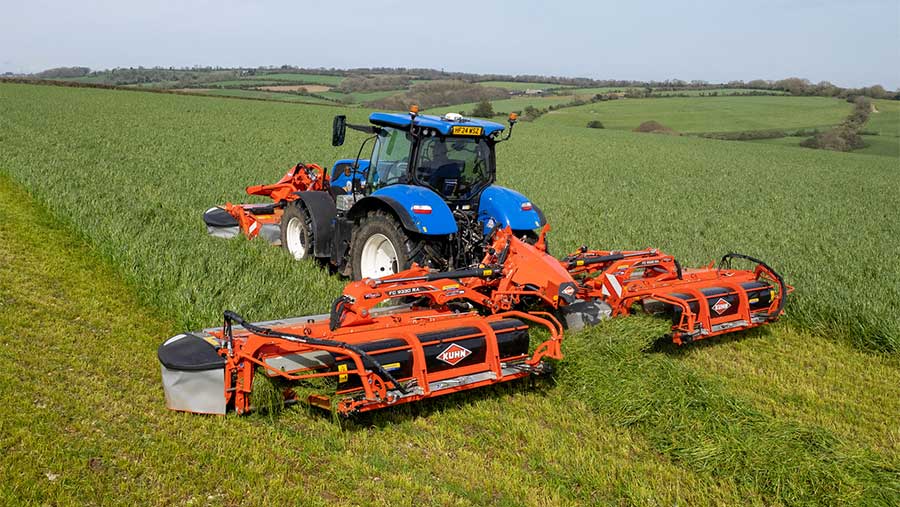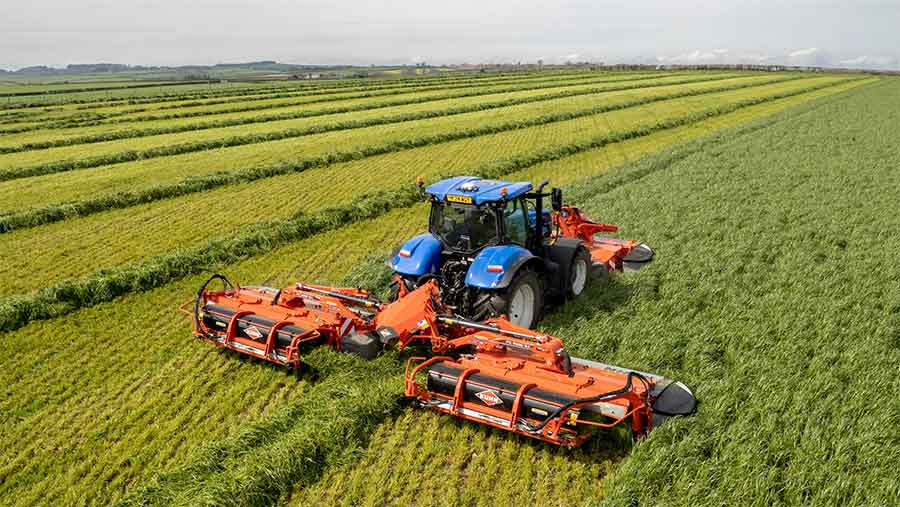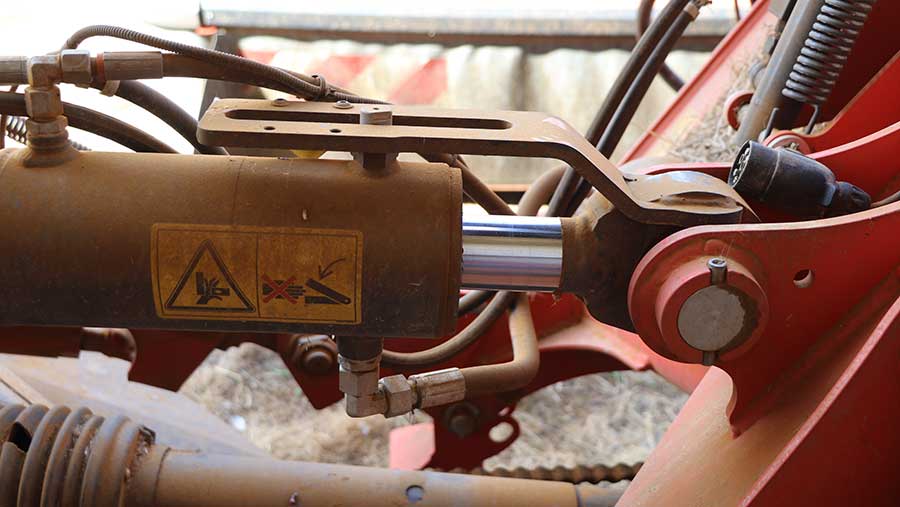Advertiser content
Triple mowers with swathers streamline forage system
The wrong settings on stony ground can drastically reduce silage and hay quality during raking, but Dorset contractor WT Box has solved this problem through a system that relies on a set of swathers fitted to his rear Kuhn butterfly mowers
Mower swathers may not be everyone’s preferred method, but when you’re dealing with flints the size of your head, Will Box has limited options to keep contamination in his silage, hay and haylage to a minimum.
To overcome this issue, he invested in a Kuhn rear butterfly FC 9330 RA mower, and a front FC 3125 DF mower, with swathers on the rear beds to create a central swath ready for collecting, without using a rake.

Will Box runs a streamlined silaging system and his new Kuhn FC 9330 RA and front FC 3125 mower setup has reduced contamination and improved swath formation © KUHN Farm Machinery
I wanted a set of mowers that could comfortably drop enough grass in a day to keep the forager busy for around two days, with a day of drying in the middle.
His previous mower, a Kuhn FCT 3160 rear centre pivot machine, was at its output limit and to maintain his customer base and ensure quality for all, he knew the mowers were his restricting factor. He explains the main reasons for choosing the outfit.
“We run a system that relies on high mowing output to leave the grass in rows to dry consistently before a trailed forager picks it up.
“I wanted a set of mowers that could comfortably drop enough grass in a day to keep the forager busy for around two days, with a day of drying in the middle.
“Our biggest problem is flints, which means contamination is high when raking grass across the surface.
“This can also lead to machinery damage, both at harvest and when feeding out, so the swathers to improve forage quality whilst reducing passes.
“The compromise is that the grass dries in rows, which obviously takes a bit longer.” says Will.
Alongside the Kuhn mowers, Will runs a trailed forager, chopping around 240ha a year, along with producing 6,000 round bales and 5,000 square bales, as well as slurry spreading.
He also supports local farmers in the Wimbourne and Dorchester areas from his base at Whatcombe Down Farm, near Blandford, Dorset.
With a busy contracting service and only one other staff member, efficiency of operations is key.
Efficient system
Will’s streamlined system starts with a day mowing with the triple setup before leaving the grass to dry in rows for 24 hours and picking it up on the third day.
Although moving the grass speeds up drying, the risk of contamination from flints, and an extra job for a small business, means the swathers are essential.
“Swathing offers the ultimate efficiency, and the drying day allows us time to get ready for picking up the rows.
“The mowers are fixed to a New Holland T7.225 and I can comfortably cover 80ha/day in the small fields we farm around here.”
Will says the mowers have not only increased output but the balanced setup, with one bed each side and a Kuhn FC 3125 DF unit on the front linkage, has meant turning on some of the steeper ground is now much safer.
“The swathers and steel finger conditioner adds significant weight to the rear beds, so the front mower helps to counteract this and the whole setup is a lot more planted than the older front and rear mower I had.
“This helps with grip on the steep land and is useful on first cut if it’s still soft ground in early April.”

The Kuhn mower setup has reduced contamination from the large flints across the area Will farms © Lucas JB Photography
Swath shape and quality
Further benefits of the triple mower setup have been seen in the swath formation, which Will says has made a marked difference to baler output and the uniformed shape of each bale.
Sensors on the swathers alter the conveyor belt speed depending on the angle of the beds, directed by an inclinometer.
When mowing across a hill, the belt on the lower side will automatically speed up to account for throwing grass up hill, whereas the higher belt is slowed to prevent propelling grass over the swath. Will explains how this helps the swath shape.
“Our previous mowing combination left a triangle shaped swath with more grass on the side of the rear mower.
“This was lumpy in places and impacted the shape of the bales, causing us to weave up the rows to create even bales.
“The triple mower combination creates an even swath that is the width of the baler intake, and means the shoulders of the bale are always full.”
The swath groupers can be lifted out of work when customers don’t require them.
However, all of Will’s silage customers are now pleased with them and the reduced contamination in the forage.

The optional swathers on the rear of the Kuhn FC 9330 RA rear mowers can be adjusted to suit the crop density and the terrain © Lucas JB Photography
Reduced wear
By not moving grass across the Dorset stubbles, the lower impurities has helped minimise wear on feeder wagons.
Part of this is also down to the Lift-Control suspension on the Kuhn triple mowers, which ensures constant pressure across the beds, with hydraulic cylinders quickly adapting to changing ground conditions.
The system monitors the rearward force on the mowing deck against the cutting height, based on the parameters set by the operator.
For wet ground, bed ground pressure is reduced to prevent contamination, whereas, in dry conditions, greater pressure can be exerted on the stubble for improved cutting height. Will says the quality of the system is obvious.
“Setting the accumulators correctly will guarantee a good finish. It’s amazing to watch how much the beds float in relation to the contours and the height of cut is constant across the width.
“Getting this right means we’re producing high quality material for our customers.”

The Lift-Control system adapts bed pressure to ground conditions to ensure a consistent cutting height and reduced contamination © KUHN Farm Machinery
Dealer support
Will has several other Kuhn implements, supplied through local dealer, Buglers, and he was keen to stay with it and Kuhn due to the support received and high build quality.
“We demoed another brand but felt the build quality was better with the Kuhn mowers and our relationship with Buglers is also a big factor in the decision.
“Little extras such as lights on the mowing deck and dedicated holders for spare blades make a lot of difference,” says Will.
“I plan to keep the mowers for 10 years, so the deprecation and purchase cost is offset over a longer period.
“A set of triple mowers may appear lavish for the workload we have, but if I didn’t have them, I’d probably need another tractor and operator in peak periods, and the quality of our product would reduce,” concludes Will.
Provided by
For nearly 200 years, KUHN has been synonymous with excellence in agriculture. Our expertise is at the heart of innovative solutions at every stage of the process. Our trademark is quality, driving innovation that improves farmers' efficiency and contributes to sustainable food production.
